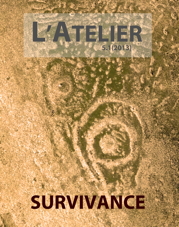Les Vestiges du SIDA: la survivance du texte
Mots-clés :
SIDA, littérature gay, maladie, mortRésumé
La littérature gay du SIDA des premières années de l'épidémie ayant pour postulat quasi-systématique la mort de l'auteur et/ou du héros, la question de la survivance semble avoir une réponse évidente : il y aurait un « avant » et un « après » SIDA, une césure historique et littéraire aussi irréversible que la solution de continuité induite par le décès de l'écrivain. Cet article se propose de nuancer l'idée que le SIDA a complètement bouleversé la littérature gay américaine en prenant d’abord comme cas d’étude les huit tomes des Tales of the City d’Armistead Maupin : best-seller depuis qu’il est paru et jusqu’à aujourd’hui, ce récit léger et haut en couleurs est souvent décrit comme la première œuvre de fiction incluant la crise du SIDA. Le premier tome datant de 1978 et le dernier en date ayant été publié en 2010, Tales of the City permet de répondre aux questions centrales de la survivance : que reste-t-il de l’ « avant » dans l’ « après » ? Les tomes « post-SIDA » sont-ils méconnaissables ? Le héros survit, San Francisco et le Castro survivent, pourquoi est-ce la technique narrative de Maupin, c’est-à-dire le texte lui-même, qui a changé ? Dans le cas de David Feinberg, qui écrivait encore sur son lit de mort en 1994, c’est l’auteur lui-même qui change : John Weir prend le relai après plus de vingt ans pour écrire la mort de son ami David. Dans ce contexte, comment s’articulent mort de l’auteur et survie du texte ?
Because in the early years of the epidemic the gay literature of AIDS almost always postulated the death of the author and/or the hero, the issue ofsurvival seems to have a single answer: there allegedly is a “before”and an “after” AIDS, a historical and literary fracture which is said to be as irreversible as that brought about by the demise of the writer. This article aims at qualifying the notion that AIDS completely disrupted American gay literature, using first Armistead Maupin's eight-volume work Tales of the City as a case study: it is a light, colorful narrative, often described as the first work of fiction that includes the AIDS crisis. Tales of the City allows us to answer questions that are at the core of the issue of textual survival: what is it that remains from the “before” in the “after”? Are the “post-AIDS” volumes really unrecognizable? The hero survives, San Francisco and the Castro survive, why has the narrative technique, i.e. the text itself, changed? In the case of David Feinberg, who kept writing while lying on his deathbed in 1994, the author himself has changed: John Weir takes over twenty years later to narrate the death of his friend David. In this context, what is at stake when the author dies and the text survives?
Publiée
Numéro
Rubrique
Licence
-
L’envoi spontané d’un article à la rédaction de L’Atelier implique l’autorisation de publication et la cession des droits dans les limites établies par la loi de propriété intellectuelle.
-
L’Atelier conserve les droits de reproduction des articles publiés, quelque soit le support : internet, CD ROM, réimpression, photocopie, etc.
-
L’auteur conserve le droit de publier ultérieurement son article déjà paru dans L’Atelier avec la seule obligation de mentionner le nom de la revue comme source de la première publication.


